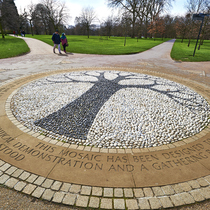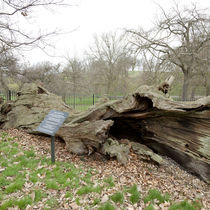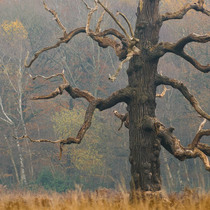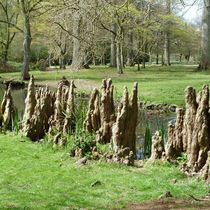Trees in the Royal Parks

There are over 170,000 trees across all 8 Royal Parks, including over 250 different varieties and around 1,500 veteran trees. From the Reformer’s Tree in Hyde Park to the Swamp Cypress tree roots in Bushy Park there are so many historical and unique trees to discover.
We’ve compiled a list of our top 10 favourite trees in the Royal Parks – read on to find out all about them.
1. Reformer’s Tree
 In 1866, the Reform League would meet around an Oak Tree in Hyde Park to campaign for the vote for all men. The tree was set alight during a protest, but the burnt stump continued as a rallying point and a symbol of the right to assemble.
In 1866, the Reform League would meet around an Oak Tree in Hyde Park to campaign for the vote for all men. The tree was set alight during a protest, but the burnt stump continued as a rallying point and a symbol of the right to assemble.
Today this mosaic sits in the same spot as the Reformer’s Tree to commemorate its importance for British democracy – you can find it here.
2. The Maidenhair tree
The Maidenhair tree (Ginkgo biloba) has existed unchanged since the Jurassic period - this remarkable tree is known as a 'living fossil', as it’s the sole survivor of an ancient group of trees that date back to beyond the time of the dinosaurs.
3. Queen Elizabeth’s Oak
 This huge Oak tree in Greenwich Park dates back to the 12th century and although it died sometime in the 19th century, only fell in 1991. Legend has it that King Henry VIII danced around this tree with Anne Boleyn, and it's also where their daughter, Queen Elizabeth I, often picnicked.
This huge Oak tree in Greenwich Park dates back to the 12th century and although it died sometime in the 19th century, only fell in 1991. Legend has it that King Henry VIII danced around this tree with Anne Boleyn, and it's also where their daughter, Queen Elizabeth I, often picnicked.
4. Fossilised coniferous tree trunks
There are fossilised coniferous tree trunks in Regents Park and Primrose Hill, which were formed around 150 million years ago! They were excavated from the Lower Purbeck beds in Dorset and placed in Queen Mary's Gardens by the Royal Botanical Society – check them out here.
5. The Weeping Beech
This is the Weeping Beech (Fagus sylvatica 'Pendula') on Nannie’s Lawn in Hyde Park – it’s known in the park as the Upside Down Tree because its branches descend from the crown and look like roots.
6. London Plane trees
We have some of the most significant avenues of London Plane trees (Platanus x hispanica) in the world. They were planted during the Industrial Revolution in the late 19th century – their distinctive camouflage-looking bark absorbs air pollutants making it the perfect tree to filter pollution in a busy city.
7. Veteran Oak trees
 Ancient English oak trees (Quercus robur) in Richmond Park used to be pollarded, which means cut back so that the deer can't reach them, to stimulate growth of the timber for harvesting. This also prolongs the life of the trees and creates very wide trunks! One of the oaks is around 700-800 years old...
Ancient English oak trees (Quercus robur) in Richmond Park used to be pollarded, which means cut back so that the deer can't reach them, to stimulate growth of the timber for harvesting. This also prolongs the life of the trees and creates very wide trunks! One of the oaks is around 700-800 years old...
8. The Lightning Tree
This oak tree was struck by lightning on 2 June 1992 - we conserved it because it provides a wonderful habitat for invertebrates and fungi.
You can find the Lightning Tree in our secret garden in Hyde Park – find out more about our eco-building and education centre here.
9. Swamp Cypress
 Swamp Cypress (Taxodium distichum) tree roots can be found in Bushy Park, Richmond Park, St James's Park, Regent's Park and Primrose Hill and Greenwich Park.
Swamp Cypress (Taxodium distichum) tree roots can be found in Bushy Park, Richmond Park, St James's Park, Regent's Park and Primrose Hill and Greenwich Park.
Cypress trees growing in swampy areas tend to have a peculiar growth called ‘cypress knees’ - these are woody projections sent above the normal water level, roughly vertically from the roots like the ones pictured here!
10. Big Cone Pine
The Big Cone Pine (Pinus coulteri) in Bushy Park produces, as the name suggests, giant pine cones – as big as pineapple! - weighing up to 5 ½lb (2.5kg). This species of Pine tree is native of the United States and was planted in memory of the World War II American base.
You can help protect the trees in the Royal Parks by adopting a tree, it’s really simple and will only take a couple of minutes, and you will receive a beautiful personalised adoption pack. Find out how to adopt a tree in the Royal Parks here!